Matchday five of the Premier League had brought us some interesting matchups with the involvement of the big names. Two clubs that faced each other on Saturday evening were Wolverhampton Wanderers and Chelsea. Last season, Wolves were one of the dark horses of the league with their attractive style of play, they eventually finished seventh in the league and qualified for the third qualifying round of the Europa League.
This season, they have advanced further in the competition but faced a struggling start to the season. Nuno Espiríto Santo’s side wanted to turn things around when they welcomed Chelsea to the Molineux. On the other hand, Frank Lampard and his players have had a decent start, securing one win and two draws after five matches. With high confidence among the squad, they managed to continue their unbeaten streak up to four matches with a thrilling 5-2 win over Wolves.
This tactical analysis will provide an analysis of the goal-thrilling match between Wolverhampton and Chelsea. Meanwhile, using statistics, we will analyse what went wrong for Wolves’ tactics against Chelsea’s tactics.
Lineups
The home side entered this match with their familiar formation of a 3-5-2. They were left without Willy Boly as the French defender was sent off in their loss against Everton before the international break. Romain Saïss was chosen to replace his role and he completed the back-three that consisted of Jesús Vallejo and captain Conor Coady. Matt Doherty was also available for this match but only made the bench as his position was occupied by Adama Traoré.
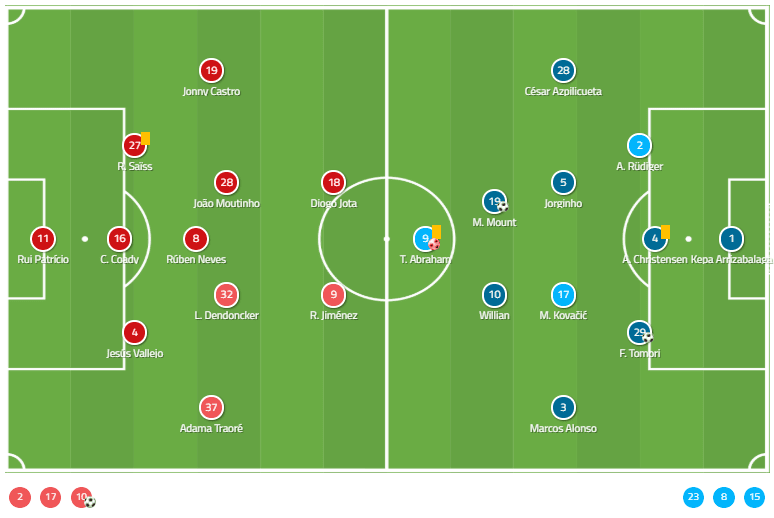
Lampard made a few adjustments to the side that secured a point against Sheffield United. With the return of German defender Antonio Rüdiger, he changed the team’s 4-3-3 formation into a 5-2-2-1. He completed the back-three that already consisted of Andreas Christensen and Fikayo Tomori. Mateo Kovačić was also given the nod to remain in the starting lineup while Marcos Alonso was chosen to fill in Emerson’s left wing-back spot.
A goal-thrilling first-half for Chelsea
Immediately after the start of the match, Chelsea showed their intention of building attacks from the backline. They had three centre-backs who were comfortable with the ball and could make penetrative passes towards the attackers. These defenders would stay close to each other, or more specifically, inside the central area, to keep the risk level of their passes as low as possible.
On some occasions, both central midfielders could also drop deep to create a passing block inside the middle third. They came deep to offer possible passing options for the defenders to keep them away from making long passes towards the strikers. Both Jorginho and Kovačić all had the trait of getting the ball deep inside their half and then drive forward with pace, especially the Croatian midfielder.
He acted as the link between Chelsea’s passing block with the attackers up front. The option of laying the ball off to the likes of Mason Mount or Willian when he reached the edge of the final third was occasionally viable to him. It allowed the attacking midfielders to stick to their respective positions and not dropping deep too often.
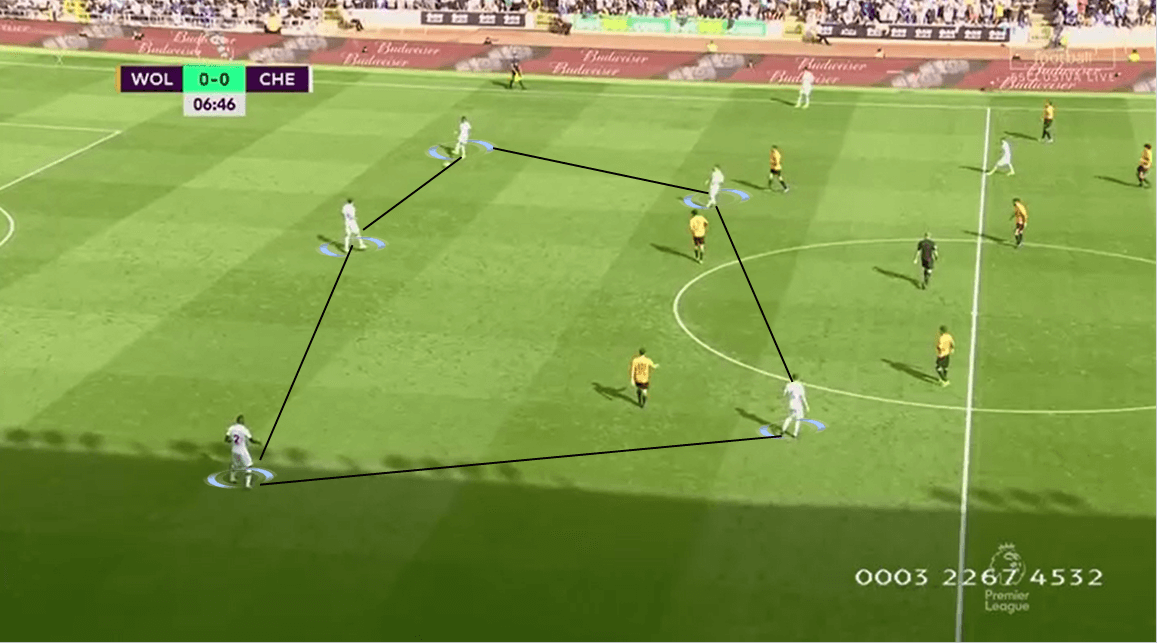
At the same time, both wing-backs also had the option of remaining in their positions to provide passing options. But they would only do so when Wolves attempted to win numerical superiority with their press. There were two potential receivers outside of the overloaded area and always ready to pick up the ball for the upcoming attack.
While Alonso was more of an attacking wing-back who tended to receive the ball for his overlapping runs, César Azpilicueta usually stuck to his position and even drifted inwards. Having mostly played as a ball-playing centre-back last season, the former Marseille defender provided a solid passing option for his teammates.
It was also from the left-hand side where Alonso sent a cross into the box for Tammy Abraham to score his second goal of the game. After picking up the clearance, the Spaniard wing-back noticed Abraham, who intended to move ahead of his marker. The cross was exquisite and found his head which allowed him to head it home. Also notice how free Abraham and Mount were even though Wolves had won the numerical superiority inside the box. They had seven players who should have left them in their sights, but instead, allowed them to move into free space and pick up the ball.
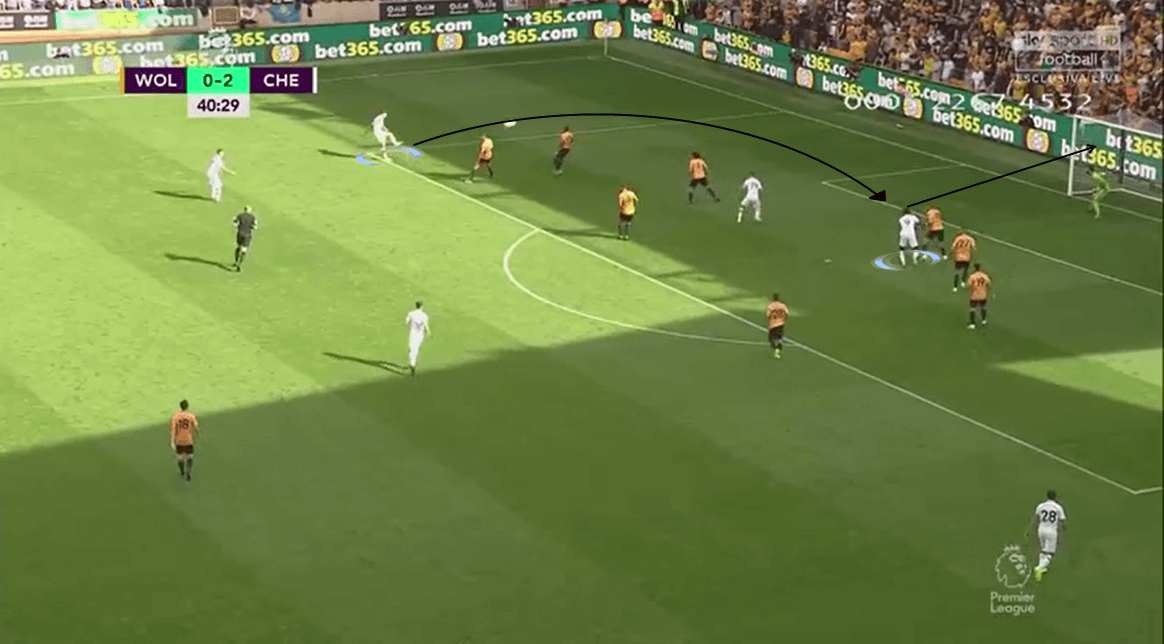
Although the away side only created four chances in the half, three of them were converted into goals and even Abraham’s brace reached a high xG rating. In total, he registered half a goal (0.5 xG) for the two chances he had. Still, the English youngster overperformed the numbers to up his team’s tally to three goals before half-time.
Meanwhile, Wolves struggled to limit Chelsea’s attacking threat although they lined up in a formation that could be turned into a defensive juggernaut. Off the ball, the home side maintained their 5-3-2 formation while pushing higher up the pitch. Their shape usually positioned on the edge of the middle third and aimed to swarmed the area with men.
Their defensive line would stretch wider to occupy both the wide areas and the central area. This allowed them to vacate the gaps on the field and they also received support from the midfielders. With the responsibility of screening the space in front of the defensive line, Leander Dendoncker would drop deeper than his teammates. The Belgian destroyer’s responsibility was to intercept any passes that came towards the edge of the middle third and predicted the runs of Chelsea’s attackers to stop them.
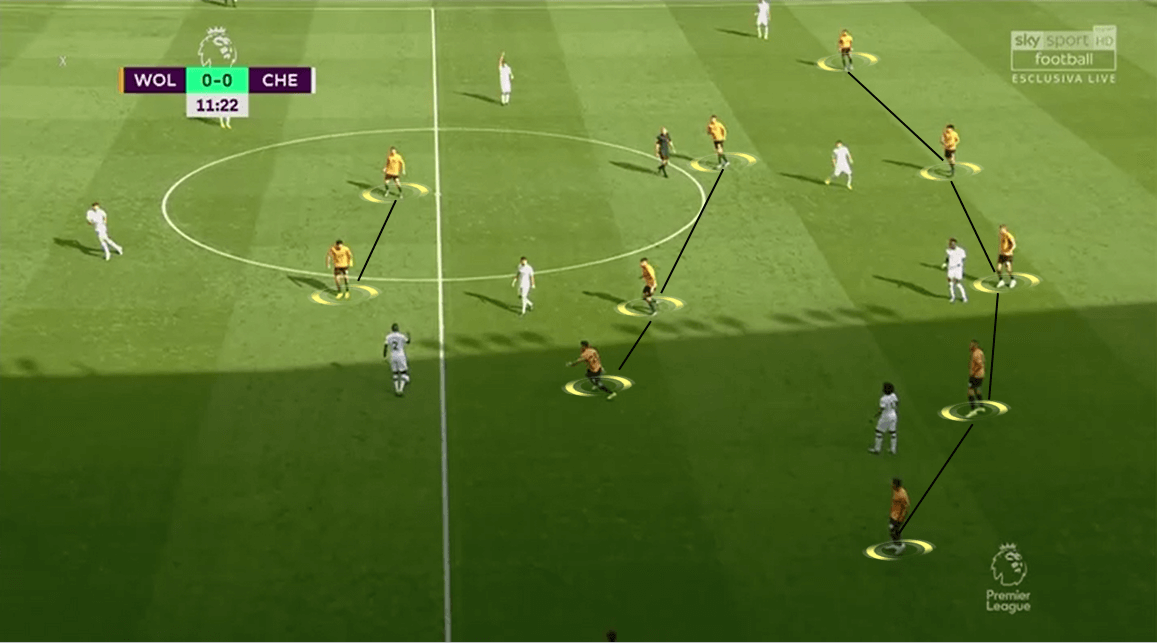
Up front, the midfielders were also involved by combining with the two strikers to form a pressing block that shifted flexibly across the pitch. They aimed to disrupt Chelsea’s build-up by winning the superiority in numbers. They also created an overload in certain areas where they passed as this allowed them to isolate the central midfielder who dropped deep and provide support.
Raúl Jiménez and Diogo Jota were tasked to close the centre-backs down. This would limit the ball carrier’s passing options and force him to play a long ball. When the ball reached the halfway line, the midfielders will surround the ball-carrying player and suffocate his passing options. He had no choice but to clear the ball out of the area or turn his attention towards the goalkeeper for a backpass.
Their strategy proved to be effective during the first few minutes, but Chelsea countered it later using their five-man build-up that we have analysed. Wolves had no choice but to retreat to their shape and then started the press as a group. They still kept their principles of having more players inside a certain area to pin down the opposition’s attackers though.
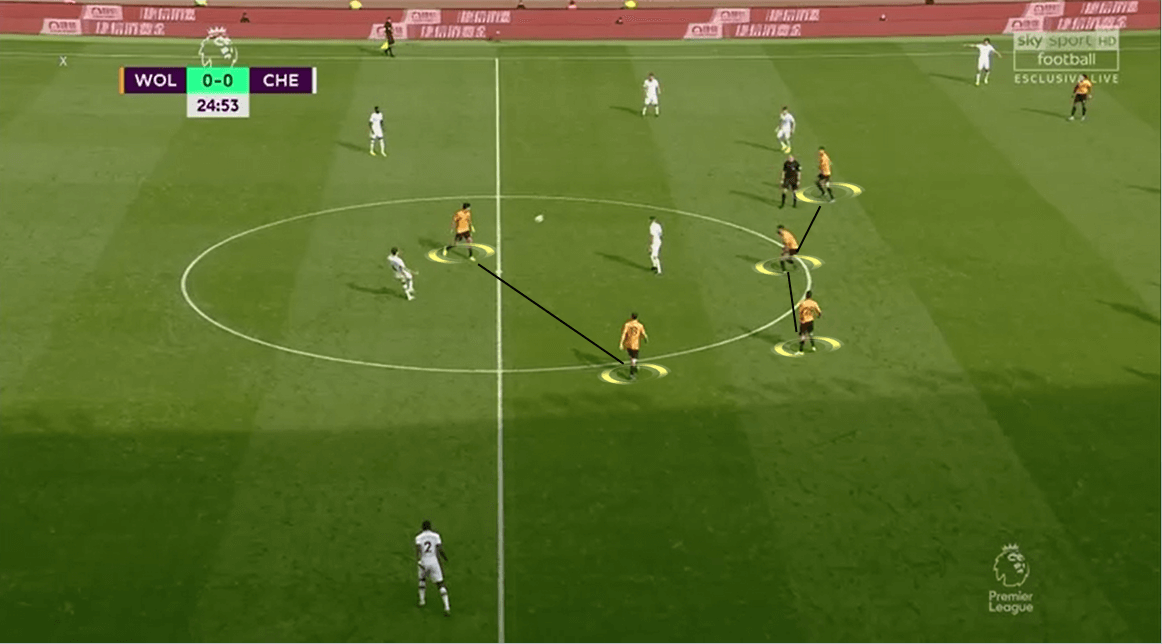
In possession, the home side relied on quick and short combinations to bypass Chelsea’s stubborn defensive structure. When the home side tended to fill their half with players, Wolves had to use their players’ positioning to progress the ball towards the final third. In the situation below, João Moutinho combined with the two strikers up front to create a passing triangle and bypassed the pressure from five Chelsea players.
Also, they were a wing-oriented team not only inside the first half but also throughout the match. From the back, the centre-backs usually distributed the ball wide for the wing-backs to overlap up the pitch. Jonny and Traoré were two players who had the pace to beat his marker and approach the final third constantly. They sometimes dribbled on their own to attract the attention of the opposition defenders and created space centrally for the strikers and midfielders to move in. Still, they didn’t have much luck in threatening Kepa Arrizabalaga with just only one chance created during the half.
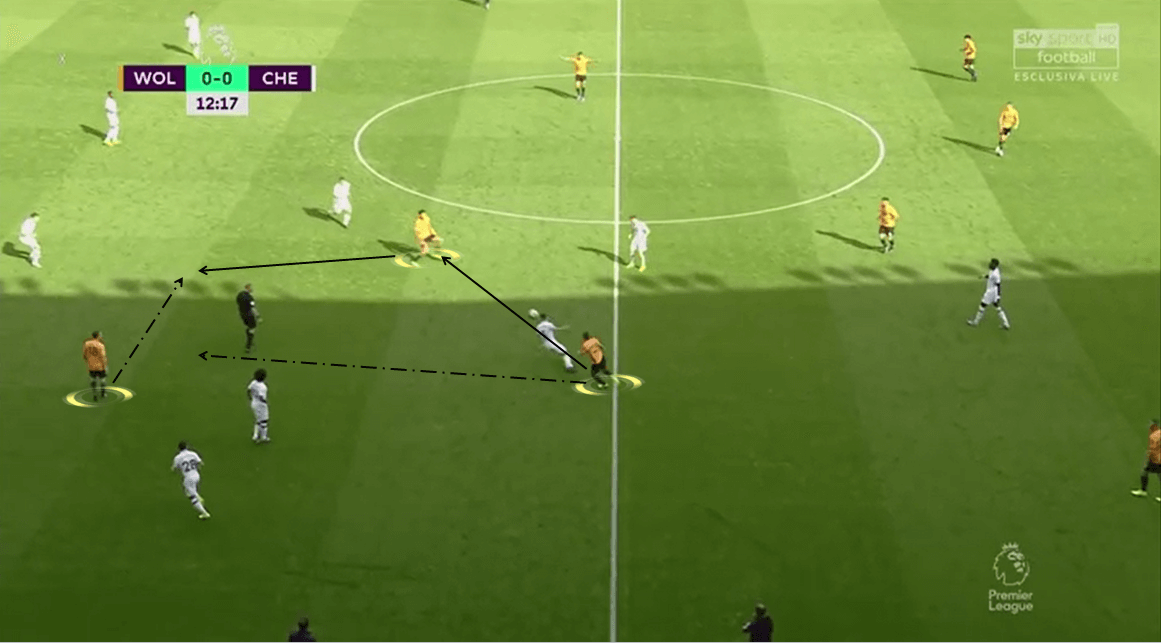
A complete revamp wasn’t enough for Wolves
Things hadn’t changed much when the second half started and became even worse for Wolves as Chelsea found their fourth goal. Capitalised on the fact that the home side pushed their defensive line too high, Jorginho made a lofted pass into the space behind the line. While the defenders were still retreating, the Italian midfielder’s pass found the run of Abraham as he attempted to beat the pressure from Coady.
Still, the former Aston Villa loanee was one step ahead of the Wolves captain to pick up the ball and shield it until he reached the box. By stopping the ball and making a quick feint, Abraham was able to have a clear perspective on Wolves’ goal for a dipping shot into the bottom left corner.
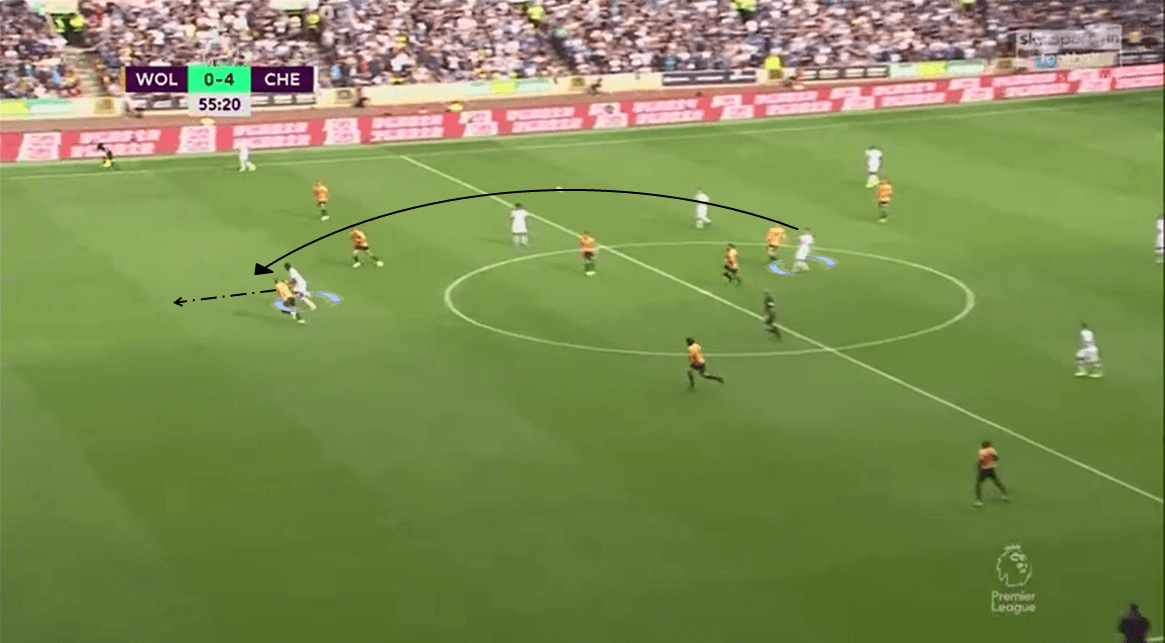
The fourth goal had an impact on the team’s confidence but they didn’t let it hamper what they intended to do. Instead, Wolves had a big step up in terms of creating chances towards Chelsea’s goal. With seven chances throughout the half, it’s clear that they had pushed their mentality up to find the consolation goal for their home fans.
After five blocked or wide attempts, things were started to brighten for Wolves. Saïss and Doherty came close as their chances were on goal but it wasn’t highly rated in xG and Kepa denied them.
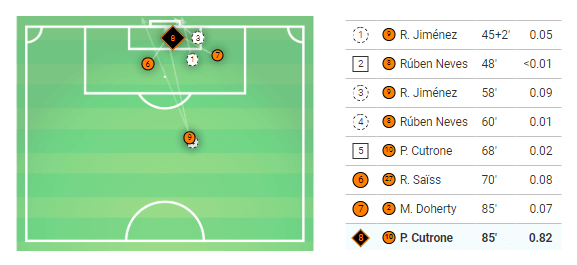
But during the same situation which led to Doherty’s shot on target, substitute Patrick Cutrone was quick enough to make a rebound to score the second goal for Wolves. Speaking of Cutrone’s goal, it’s worth noticing the pass that allowed Doherty to approach the box and have a shot.
After noticing Doherty was overlapping into the area behind Chelsea’s defensive line, substitute Morgan Gibbs-White picked him out with a lofted pass. The young English midfielder picked his teammate out exquisitely and allowed him to continue his run into the box. But since he received the ball in a very narrow angle, his shot was easily saved by Kepa. The Spaniard couldn’t keep hold of the shot and it was deflected out. As he positioned near the 6-yard box, Cutrone approached and took a shot into the net.
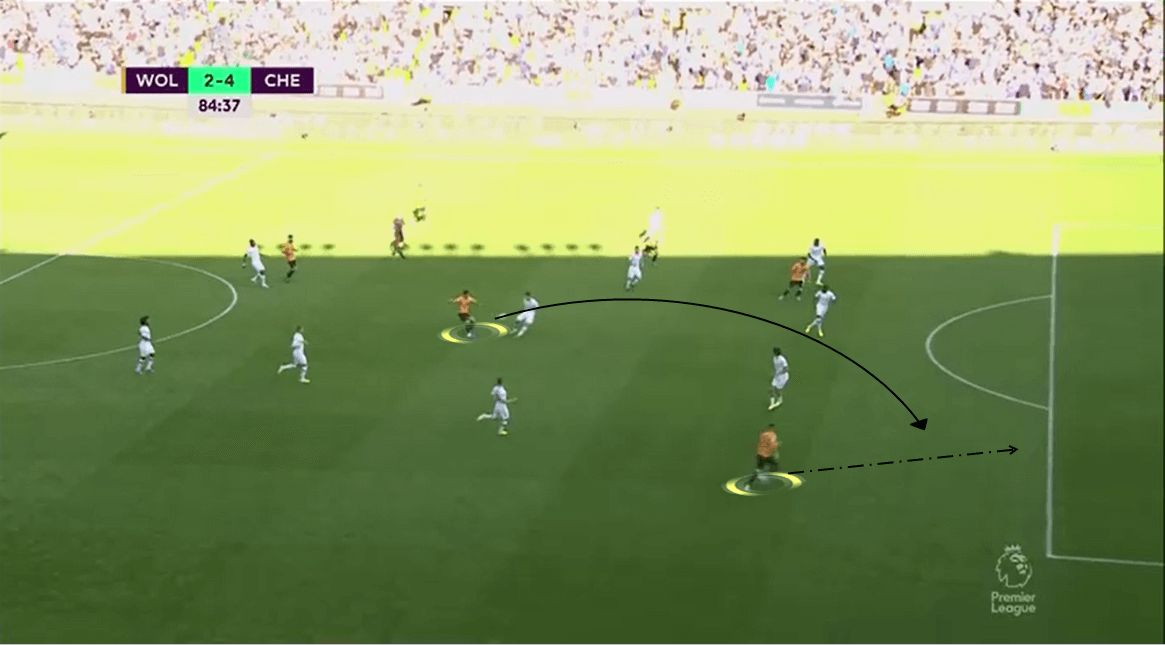
One of the reasons that helped Wolves create so many chances after the 50th minute was they used quick movements to capitalise on the gaps in between Chelsea’s defenders. In the shot below, Cutrone noticed a gap was opened in front of the box. While he continued his run, Moutinho fed him up with a delicate through ball into the area.
The home side made the most out of this attacking method inside the second half and it contributed to their big improvement. Still, it wasn’t enough for Wolves to turn the game around and Chelsea returned home with a thrilling 5-2 win after Mount scored the decisive goal at the 90+6th minute.
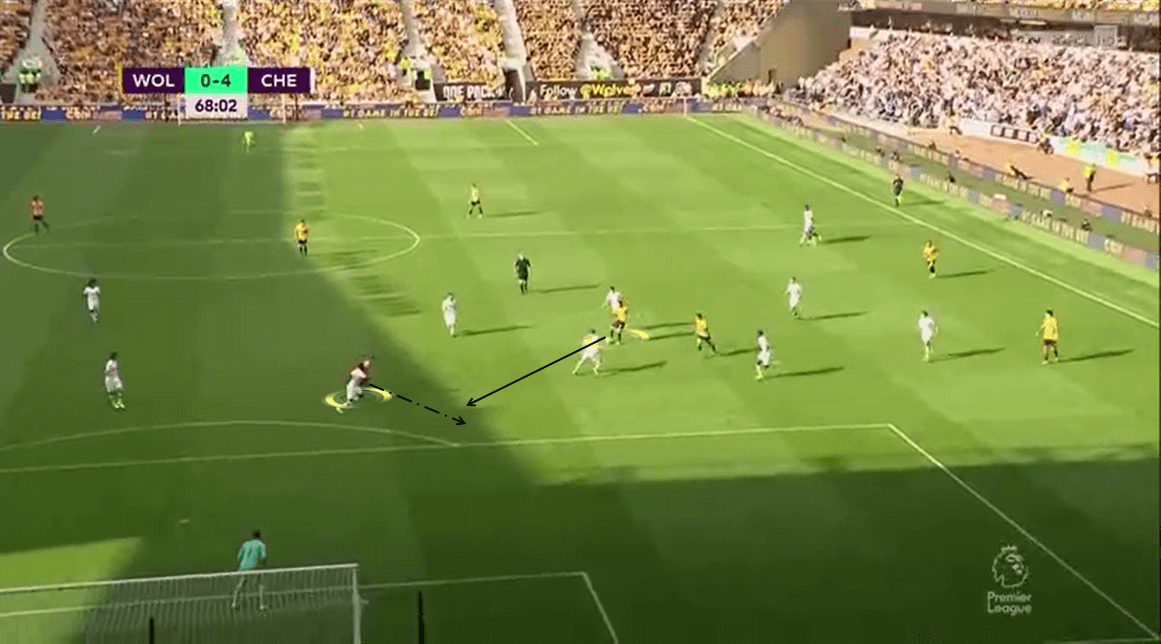
Conclusion
By securing a dominant win over Wolverhampton, Frank Lampard and his side maintained their unbeaten streak and even up their tally to four. They even became the third-highest scoring team with eleven goals. It’s quite easy to understand the high confidence and morale as they aim to bring it into their match against Liverpool at Stamford Bridge.
Meanwhile, it seems like Wolverhampton have started to show signs of tiredness when they have to spread the team for both the domestic league and the Europa League. They have had a very struggling start in the Premier League with only three draws to their name. It is necessary for Wolves to shake things up to pick up their form from last season and to return to their best state.

If you love tactical analysis, then you’ll love the digital magazines from totalfootballanalysis.com – a guaranteed 100+ pages of pure tactical analysis covering topics from the Premier League, Serie A, La Liga, Bundesliga and many, many more. Buy your copy of the August issue for just ₤4.99 here





Comments